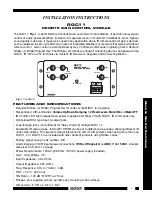
Testing __________________________________________________ Boomer-III User Manual & Integrator’s Guide
Copyright Wavenet Technology © October 2003
76
BM310012WT04
modem . The ability to turn on and off the various circuits in the
host/terminal allows for the identification and analysis of the
host/terminal components that are responsible for desense. This
approach to desense troubleshooting can greatly speed up the OEM
integration effort.
For more detailed information about desense, refer to “Guide to
Desense” on page 132.
Regulatory Compliance
Most countries where the final product will be sold generally require
approval from the local government regulatory body. In the US, the
FCC requires that two individual requirements be met before the final
product can be certified. The first test, the FCC Part 15 qualification,
requires you to prove that the product electronics hardware does not
yield local radiation capable of affecting other equipment, such as TVs,
computer monitors, and so on.
The second test (FCC Part 90) requires you to prove when the modem
transmits, it remains properly in its allocated channel spacing, and does
not produce spikes or splatter in other frequencies. Wavenet undergoes
FCC testing with the modem stand-alone to ensure compatibility with
these requirements. But since the eventual transmit capability of the
modem is highly integrated with the power supply and antenna system
of the host/terminal, the fully integrated product must be submitted for
final regulatory approval.
In addition, regulatory bodies can require the wireless modem to
transmit random data patterns on specific frequencies while
incorporated in the host/terminal. The Boomer-III OEM modem
incorporates special debug modes to allow this kind of testing,
provided the host/terminal application can issue the required
commands to the modem.
The entire regulatory process can take many months to complete and
should start early in the development cycle. The exact regulatory
requirements of each country change from time to time. For efficient
regulatory processing, it is recommend to use the services of
specialized regulatory consultants to determine the specific
requirements at the time of manufacture.
To prepare for regulatory testing, you need to integrate the pass-
through mode into the product design (see “Enabler Functions” on page
74). Wavenet provides the ability to key and dekey the radio at the
required frequencies and modulation levels from an external PC via the
pass-through mode.
For further information about regulatory compliance, refer to
“Regulatory Requirements” on page 19.
















































